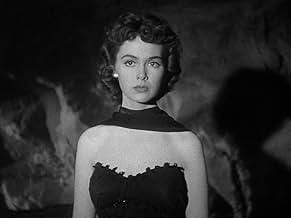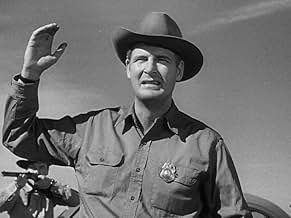Un vaisseau spatial d'un autre monde s'écrase dans le désert d'Arizona et seuls un astronome amateur et une institutrice soupçonnent une influence extraterrestre lorsque les habitants de la ... Tout lireUn vaisseau spatial d'un autre monde s'écrase dans le désert d'Arizona et seuls un astronome amateur et une institutrice soupçonnent une influence extraterrestre lorsque les habitants de la ville commencent à se comporter bizarrement.Un vaisseau spatial d'un autre monde s'écrase dans le désert d'Arizona et seuls un astronome amateur et une institutrice soupçonnent une influence extraterrestre lorsque les habitants de la ville commencent à se comporter bizarrement.
- Réalisation
- Scénario
- Casting principal
- Récompenses
- 1 victoire et 4 nominations au total
- Posseman
- (non crédité)
- Dugan
- (non crédité)
- Man
- (non crédité)
- Sam
- (non crédité)
- Dave Loring
- (non crédité)
- Dr. Snell
- (non crédité)
- Perry
- (non crédité)
- Posseman
- (non crédité)
- Bob - Dr. Snell's Assistant
- (non crédité)
- Toby
- (non crédité)
- Posseman
- (non crédité)
- Mrs. Daylon
- (non crédité)
Avis à la une
Arnold uses Theremin music to great effect, the photography is eerie, dialog (by Ray Bradbury) poetic, and the alien is a large crawling mass with one bulging eye that leaves a snail-like trail in its path. Incognito as humans so as not to terrify earthlings with their unique physicality, the aliens are NOT bent on destruction - an interesting precursor to Steven Spielberg's expensive "Close Encounters of the Third Kind" (1977) - even its main titles are also at the end.
In an unconscious insight into social behavior, a scene has Carlson speaking to the sheriff (Charles Drake) while watching a spider on the desert ground ("...Why are you afraid of it? Because it has 8 legs, its mouth moves from side to side, instead of up and down? What would you do if it came towards you?"). The sheriff squashes it. This holds true for animals, as well as people (who have different coloring, etc.), avoiding, ridiculing, harming or destroying, sadly. The classic Twilight Zone episode "Eye of the Beholder" (1960) is a fine example: most of the "monsters" in these science-fiction/horror films just look different than humans, we might be "monsters" to them. This is low-key, intelligent, satisfying drama. Russell Johnson, Joe Sawyer, and Kathleen Hughes co-star.
A moody and beautiful movie, with fine music by Henry Mancini. Many fans of Jack Arnold's sci-fi films consider this one his best (although personally I prefer `The Space Children' -- and so did Jack Arnold, according to his own statement).
Charles Drake (`Tobor the Great') is the skeptical sheriff. Russell Johnson plays both a human and an alien (a treat for genre' fans). The supporting cast includes Joe Sawyer and Kathleen Hughes. Special effects by David S. Horsely and the great Clifford Stine. Makeup by Bud Westmore, of the famous Westmore family who contributed much to all the `Star Trek' spin-offs.
Originally released in 3-D. A 3-D tape was available a few years ago, but the quality was not good . . . sad to say.
This is a thoughtfully crafted film, which like other good science fiction films of this era starts out portraying the aliens as monsters, only to reveal that they are benevolent and superior (how does this fit into the "Red Menace" theory?).
The screenplay was penned by Ray Bradbury and is full of very good dialog and ideas, especially the notion that we are not ready to meet such advanced civilizations. The scenes in the high desert are very atmospheric and creepy, and although the renderings of alien technology at first seem somewhat adolescent, there is a genuine sense of wonder when the internals of the alien ship are revealed. Something missing from today's, blase, computer generated, over the top, excesses.
The 3D is a useless appendage, and not worthy of discussion.
If you like science fiction pre-scifi channel and post-golden age, rent this movie and enjoy the atmosphere.
Between about 1975 and 1986, three 1950s sci-fi films were held in very high regard by me - It Came From Outer Space, Forbidden Planet and The Incredible Shrinking Man. All three were liked so much I constantly listened to them on audio tape. They were regarded as solid sci-fi movies to be taken very seriously. Then in the late 1980s I made the mistake of seeing these films in Sydney theatres with people who were not really in tune with 1950s movies. These films became comedy to them.
ICFOS begins with the male and female lead getting all romantic with each other. This cinema crowd almost laughed this scene off the screen. Too corny for them. Later, one character describes Richard Carlson as "a man who thinks for himself", the laughing was louder this time. And again, Carlson looks into space and starts talking to himself, out loud, about aliens. The laughing was getting stronger. And so it went on. What was once great mystery and suspense, such as Russell Johnson looking into the sun, was now comedy. They had good reason to laugh as it was funny. But this crowd destroyed a childhood favourite of mine. I did'nt like this film being laughed at. I did'nt want to know the funny side. Other cinema screenings of Forbidden Planet and The Incredible Shrinking Man were given the same reaction. For a while I wondered if all of my 1950s/1960s sci-fi favourites were just ... bad in the eyes of the public. Or was it just the Australian sense of humour?
I will rate this film by my 1970s reactions. It is a classic. The music score is dated but everything else is fine. The desert creates such mystery. Great sci-fi.
Le saviez-vous
- AnecdotesAlthough credited to Harry Essex, most of the script, including dialogue, is copied almost verbatim from Ray Bradbury's initial film treatment.
- GaffesWhen the alien first goes walking about in the desert, the camera cuts to a startled owl, which tries to fly away only to be jerked back by the visible string tied to its leg.
- Citations
Sheriff Matt Warren: Did you know, Putnam, more murders are committed at ninety-two degrees Fahrenheit than any other temperature? I read an article once - lower temperatures, people are easy-going. Over ninety two, it's too hot to move. But just ninety-two, people get irritable.
- Crédits fousThe credits are at the end rather than at the beginning. They include shots of the characters with the cast names, and the pictures would mean nothing if seen before the film.
- Versions alternativesThere is an Italian edition of this film on DVD, distributed by DNA Srl: "IT CAME FROM OUTER SPACE 3-D (1953) + L'UOMO DAL PIANETA X (1951)" (2 Films on a single DVD, with "Destinazione Terra!" in double version 2D and 3D), re-edited with the contribution of film historian Riccardo Cusin. This version is also available for streaming on some platforms.
- ConnexionsEdited into La Cité pétrifiée (1957)
Meilleurs choix
Détails
Box-office
- Budget
- 800 000 $US (estimé)
- Montant brut mondial
- 270 $US
- Durée1 heure 21 minutes
- Couleur




































